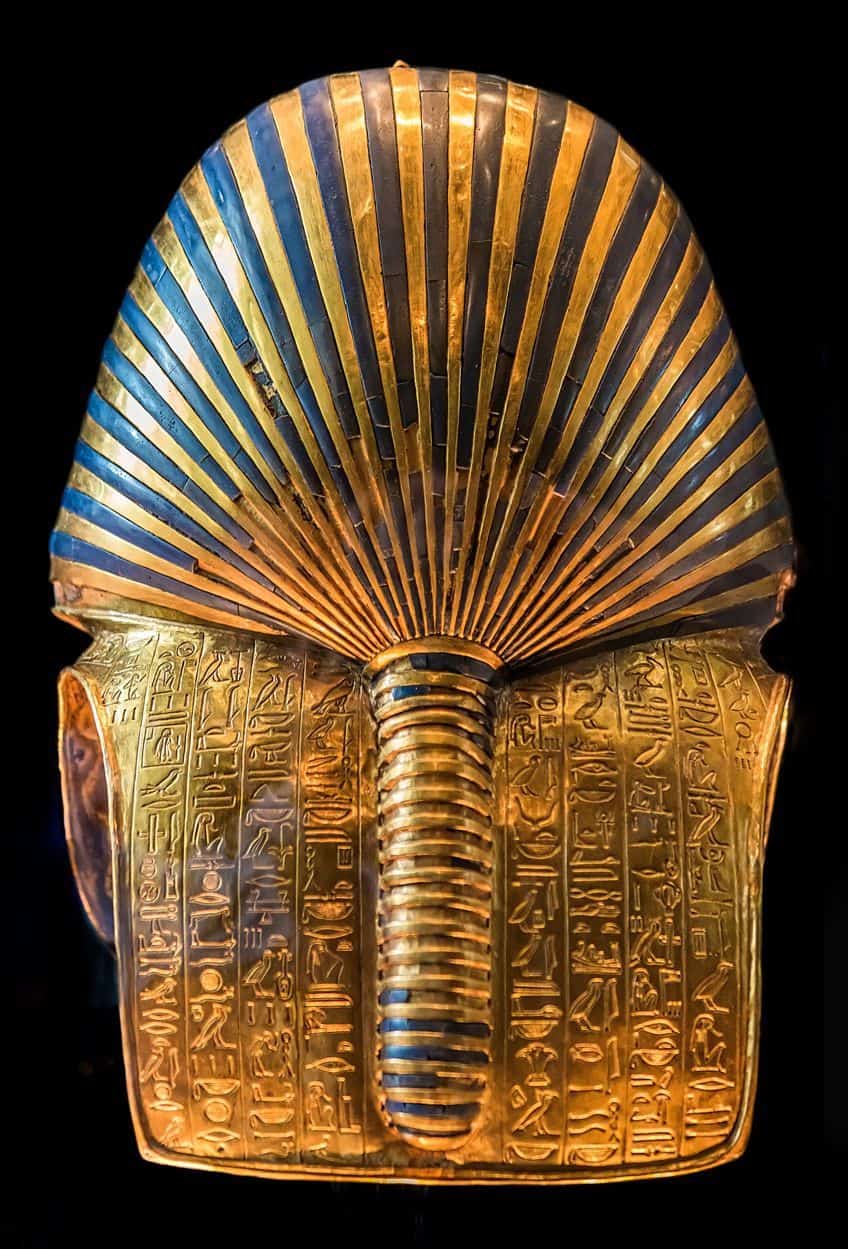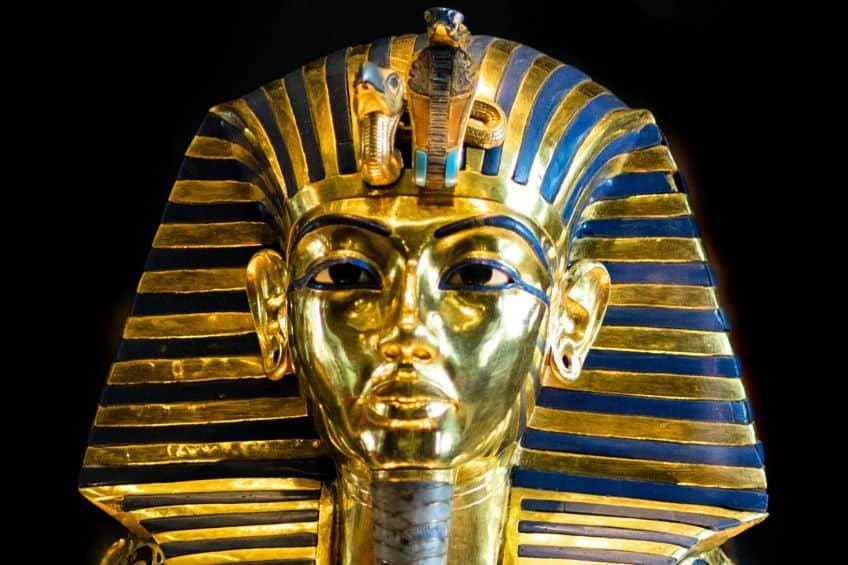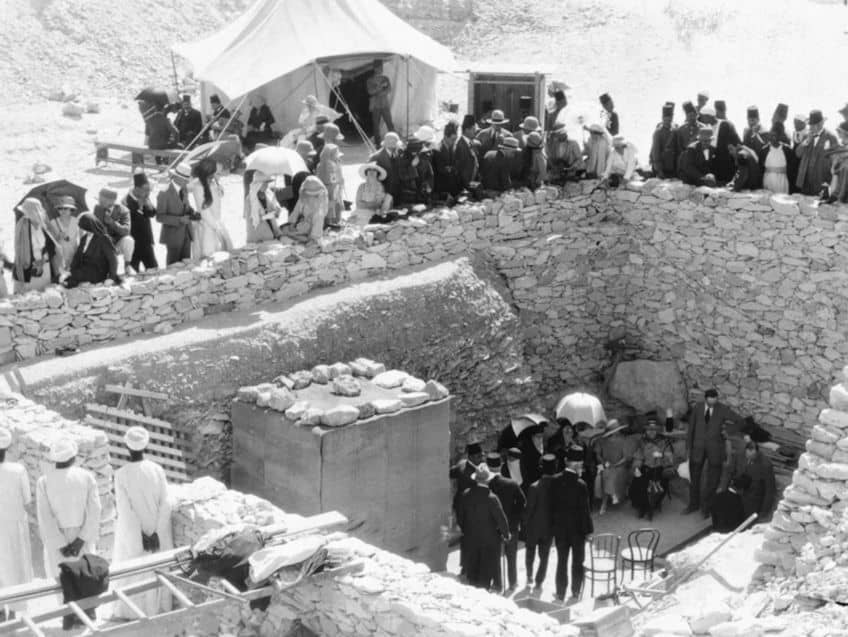Mask of Tutankhamun – The Funerary Mask of Tutankhamun
You may have heard of the young Egyptian king known as Tutankhamun, who ruled ancient Egypt for nine years and whose famous golden funerary mask was discovered in 1925 by Howard Carter. The nine-year-old king and his advisors did their best to restore Egypt to its full glory following the economic downturns of the previous ruler, Tutankhamun’s father, Akhenaten. One of the most iconic remaining images of Tutankhamun is the funerary mask of Tutankhamun, which we will unpack in the article below.
King Tutankhamun of Ancient Egypt
| Name | Tutankhamun (also referred to as Tutankhamen, Ra, Nebra, and King Tut) |
| Date of Birth | c. 1341 BCE |
| Date of Death | c. 1323 BCE |
| Reign | c. 1332 – 1323 BCE |
King Tutankhamun, also called King Tut or Tutankhamun, was the last king of his royal bloodline to rule Egypt in the 18th Dynasty alongside other incredibly popular kings of Egypt such as Amenhotep III and Hatshepsut. The young king commenced his reign when he was just eight years old and commanded the throne until he was 18, alongside his advisors. King Tutankhamun suffered from bone necrosis and required the use of a cane for most of his life. He was also known to suffer from other health issues such as scoliosis and several strains of malaria.
Of course, one might be shocked that such a young child would have still taken such a high-ranking position of power but with the help of two advisors, Horemheb and Ay, king Tutankhamun was able to leave his own legacy, despite the short reign.
The young king’s father was Akhenaten, also known as Amenhotep IV, who was most famous for switching the religious belief system in Egypt from the worship of multiple gods to one god called Aten. King Tutankhamun’s mother is believed to be another mummy, which was discovered in the KV35 tomb called The Younger Lady. It has often been perceived that Nefertiti was the mother of Tutankhamun but research has proven that although she may have been a candidate, genetic studies prove otherwise.

The king’s name “Tutankhamun” refers to the “living image of Aten”, the God whom Akhenaten chose for Monotheistic religious practice. Tutankhamun ended up marrying his step-sister and had two daughters whom they lost. Inbreeding was a common practice in ancient Egypt, specifically in royal families where it was seen as a way of keeping the royal lineage “pure”. This could also explain some of the king’s own deformities.
The Mask of Tutankhamun
| Artist | Unknown |
| Date | c. 1323 BCE |
| Date of Discovery | 1925 |
| Place of Discovery | Valley of the Kings, Luxor, Egypt |
| Medium | Gold, lapis lazuli, carnelian, obsidian, turquoise, and glass paste |
| Dimensions (cm) | 54 x 39.3 x 49 |
| Weight (kg) | 10 |
| Where It Is Housed | Egyptian Museum, Cairo, Egypt |
So, why was this king so important to the history of ancient Egypt? And what makes his story so interesting? One of the most interesting accounts associated with the young King Tut was the rumored “curse of the pharaohs”, whereby a few people died during the same time that his tomb was discovered. In 1922, British Egyptologist and renowned archaeologist, Howard Carter, found King Tutankhamun’s tomb in tomb KV62 at the Valley of the Kings. The discovery reached global headlines and soon the project was the only topic of interest in the press. The iconic mask was later discovered in 1925 after archaeologists opened three coffins in the tomb to reveal a mask that had remained hidden for over 3000 years. The funerary mask was created from a combination of gold, glass, carnelian, and other precious stones that give the mask its signature style.
The mask bears the resemblance to the Egyptian God of the afterlife and fertility called Osiris and weighs approximately 10 kilograms.
Not only is the discovery of the mask incredibly significant in terms of pinpointing another Egyptian king and filling up the history books, but the discovery of the funerary mask of Tutankhamun has become more than just an artifact. According to Egyptologist Nicholas Reeves, the mask of Tutankhamun is currently the most famous artifact from Egypt.

With the help of x-ray crystallography, it was discovered that the mask was made from copper-alloyed 23-karat gold and was coated in a wafer-thin layer of two gold alloys. A lighter weight shade was used on the surface of the neck and face while a heavier 22.5 karat gold was used on the rest of the surface. Like many royal funerary masks of Egypt, the mask of Tutankhamun portrayed a standard image, which was also inscribed in other areas of the tomb.
The interior layer of the mask is composed of gemstones and tinted glass with lapis lazuli and other precious stones outlining the eye and eyebrows.
On the head of the mask is a head cloth known as nemes with the iconic royal insignia of a Wadjet and a Nekhbet (cobra and vulture). These images serve as symbols of King Tut’s rule over the upper and lower section of Egypt. An interesting design on the mask’s ears are the holes for piercings, which were commonly reserved for queens and children in ancient Egyptian art, yet most kings during the 18th Dynasty wore earrings as part of their royal attire.
Purpose of the Funerary Mask
The purpose of the funerary mask in ancient Egypt was to protect the mummified body of the dead in both the physical and magical aspects. The use of gold on the masks was linked to the figures’ connection and resemblance to the Gods and served as an idealized form of the entity. King Tutankhamun’s mask was also said to hold a level of mystical or spiritual importance, given that he was a prominent royal figure. His funerary mask was inscribed with a text allegedly sourced from the Book of the Dead.
The text read, “Anubis speaks, the embalmer, lord of the divine hall, when he has placed his hands on the coffin…’Hail, O beautiful of face, lord of vision, whom Ptah-Sokar has gathered together, and whom Anubis has upraised, to whom Shu gave support…Your right eye is the night boat, your left eye is the day boat, and your eyebrows are the Ennead.”
The elaborate detail of the funerary mask and the inclusion of the sacred text resembled a form of prayer or protection for the king in the afterlife. The text further stated, “The crown of your head is Anubis, the back of your head is Horus, your fingers are Thoth, and your lock of hair is Ptah-Sokar. You are in front of [the deceased], he sees by means of you…lead him on the goodly ways, you repel Seth’s band for him and cast his enemies under his feet for him in front of the Ennead of the great House of the Noble in Heliopolis. You take the goodly way to the presence of Horus, the lord of the nobles”.
Influential Artistic Styles
Prior to the reign of King Tutankhamun, Akhenaten established his own set of beliefs around art that presented his image as the personification of the sun. The dominant art style was based on naturalistic shapes and sinuous lines adopted by many ancient artists. Subjects such as scenes of the royal family and women with elongated necks in the court were also featured in the art of the time. Art historians categorize the work as Mannerist with highly stylized elements in representations of figures. The exaggerated eye makeup on the mask of Tutankhamun is also reminiscent of one of the most definitive canons of Egyptian art and expression, even for the afterlife.

Spells from The Book of the Dead
One of the most intriguing aspects of the mask is the inscribed spell written in Egyptian hieroglyphics on the back of the mask, on 10 vertical lines and two horizontal stripes. The spell is believed to be taken from the famous Book of the Dead (2400 BCE), which contained numerous magic spells aimed at guiding a dead person through the underworld and into the afterlife. The Book of the Dead had many authors and was created over 1000 years and first appeared on funerary masks 500 years before the reign of Tutankhamun in the Middle Kingdom period.
There are many misconceptions surrounding The Book of the Dead, which is often associated with other religious texts such as the Quran or the Bible.
The significance of the inclusion of the spells along with the appearance of Osiris imagery indicated the marriage of ancient beliefs with other symbols found in the king’s tomb that showcase the difference in approach to beliefs around how kings were to be buried and how royal figures would have the power to influence the widespread religious practices and beliefs of the era they occupied. During Tutankhamun’s reign, Egypt saw the re-establishment of the ancient Egyptian religion known as Polytheism, which was previously dissolved by his father in favor of Monotheism. King Tutankhamun also began the reconstruction of old monuments that were damaged during the Amarna era (1353-1322) and re-established the worship of multiple gods.
Controversy and the Curse
The mask of Tutankhamun leaves a legacy of not only important history but also one of fear, death, and disaster. Since its discovery, there have been incidents where experts affiliated with the uncovering of the king’s tomb have died. The curse of the pharaoh’s tomb instilled fear into the hearts of people and even led one man to hang himself. The Earl of Carnarvon who financed Carter’s project eventually died of blood poisoning after being bitten by a mosquito. Another man succumbed to respiratory failure while another died in a fire. Quite evidently, the unveiling of the king’s tomb had a tremendous psychological impact on the parties involved. Another claim was made that the mask was, in fact, made for Nefertiti and not Tutankhamun with a theory suggesting that Nefertiti was the wife of Akhenaten. The claim was soon refuted since evidence arose suggesting that the mask was a custom piece made for Tutankhamun and was not dependent on the fact that it had room for earrings. Other evidence that refuted the theory included several other names inscribed on the mask that refer to Tutankhamun as “Ra” or “Nebra”.

Following this, in 2014, the beard of the mask broke off and was shoddily restored by the museum’s employees. The beard had been glued on in a quick attempt to cover up the breakage yet it did not go unnoticed and soon the mask had to be restored. The restoration project took approximately nine weeks. According to the minister of antiquities, the beard on the mask had not been re-attached to the mask since its excavation and placement at the museum in 1929. The beard was first attached to the mask in 1941 and faced natural deterioration over a period of 70 years. Luckily, due to the employees’ accidental incident, the mask eventually underwent a proper restoration.
The Role of Documentation in the Popularization of the Mask of Tutankhamun
The buildup of the archaeological project leading up to the discovery of the funerary mask of Tutankhamun was heightened by the way that the process was documented. An English photographer working under the New York Metropolitan Museum of Art, Harry Burton, documented the excavation site and helped propel the story into the media. The idea of documentation in archaeological history versus in an artistic context is two different ideas.
Archaeologically, images are taken for their documentative value of portraying facts while the act of photographing art objects in an artistic context is associated with the immortalization of the idea or concept of the existence of the object. Thus, the act of photographing and publishing the images of the discovery and the object helped in not only in the global circulation of the discovery but in the resurrection of king Tutankhamun.
Christina Riggs, author of Photographing Tutankhamun: Archaeology, Ancient Egypt, and the Archive (2018) states that the discovery of the mask of Tutankhamun arrived at a crucial period that presented the site as it was, in pristine condition, such that the public became enthralled and captivated by the story of the tomb and the king it housed.
Another significant aspect surrounding the discovery itself was that it marked a period where Egypt was being represented in a self-governing manner since it previously struggled with governance and control while dealing with the British and the Ottoman Empire. The significance of finding a very young king who governed Egypt without a colonial influence was historically profound and led to the history of king Tutankhamun being incorporated into schools and literature produced by Egyptian writers.
Burton captured the image and otherworldly presence of the golden funerary mask from all angles imaginable. The many photographs and attention given to the mask aided in cementing the idea that the discovery of this particular king was incredibly important. Other issues on the discovery of the tomb revolved around the staged photographs of Carter posing alone in the tomb, which seemed to minimize the effort put into the discovery.

Four other Egyptian workers on the site were also negated and their efforts went unseen. The workers did appear in other photographs that capture candid moments on the site but remain unnamed. Without the assistance of the workers, the objects would not have been presented as pristine had they not been for the cleaning efforts. This is reminiscent of the effects of colonialism, which was so deeply embedded with archaeology and was evident in the documentation of the excavation. The popularity of the excavation eventually declined by 1933 with the last main attraction being Burton’s photographs, of which over 3000 negative images and prints are located at the Metropolitan Museum of Art and the Griffith Institute.
The mask of Tutankhamun is perhaps the greatest treasure from the ancient Egyptian world. It is believed that Tutankhamun died from a broken leg with other details on his death remaining a scientific mystery. While previous theories claimed that the pharaoh was murdered via a blunt force trauma to the head, a CT scan revealed this to be false. The king’s mummy is on exhibit in the KV62 chamber at the Valley of the Kings within a climate-controlled box.
From the spells inscribed on the mask from The Book of the Dead to the curse of the pharaoh, it is clear that the mask resurrected not only history but belief in the mystical realm of ancient Egypt. The publicity of the mask, the role of the photographer, and the splashes of colonialism surrounding the excavation also provide additional prompts for thought around the way that art objects and artifacts are obtained as well as the psychological and social power they hold over us.
Frequently Asked Questions
Who Was King Tutankhamun?
King Tutankhamun was a pharaoh of ancient Egypt who reigned over Egypt during the end of the 18th Dynasty, between 1332 and 1323 BCE.
What Is the Mask of Tutankhamun Made Of?
The mask of Tutankhamun is made of two different alloys of gold: one in a lighter shade of 18.4 karats and the rest in a 2.5-karat coating. Other materials used to make the mask include gemstones, lapis lazuli, colored glass, carnelian, obsidian, turquoise, feldspar, faience, and amazonite.
Why Is the Mask of Tutankhamun So Famous?
The mask of Tutankhamun is famous since it is the most recognized Egyptian artifact in history discovered by famous archaeologist Howard Carter. The funerary mask is also one of the most pristine examples of ancient portraiture and is admired for its incredible workmanship.
Jordan Anthony is a Cape Town-based film photographer, curator, and arts writer. She holds a Bachelor of Art in Fine Arts from the University of the Witwatersrand, Johannesburg, where she explored themes like healing, identity, dreams, and intuitive creation in her Contemporary art practice. Jordan has collaborated with various local art institutions, including the KZNSA Gallery in Durban, the Turbine Art Fair, and the Wits Art Museum. Her photography focuses on abstract color manipulations, portraiture, candid shots, and urban landscapes. She’s intrigued by philosophy, memory, and esotericism, drawing inspiration from Surrealism, Fluxus, and ancient civilizations, as well as childhood influences and found objects. Jordan is working for artfilemagazine since 2022 and writes blog posts about art history and photography.
Learn more about Jordan Anthony and about us.
Cite this Article
Jordan, Anthony, “Mask of Tutankhamun – The Funerary Mask of Tutankhamun.” artfilemagazine – Your Online Art Source. February 16, 2023. URL: https://artfilemagazine.com/mask-of-tutankhamun/
Anthony, J. (2023, 16 February). Mask of Tutankhamun – The Funerary Mask of Tutankhamun. artfilemagazine – Your Online Art Source. https://artfilemagazine.com/mask-of-tutankhamun/
Anthony, Jordan. “Mask of Tutankhamun – The Funerary Mask of Tutankhamun.” artfilemagazine – Your Online Art Source, February 16, 2023. https://artfilemagazine.com/mask-of-tutankhamun/.


